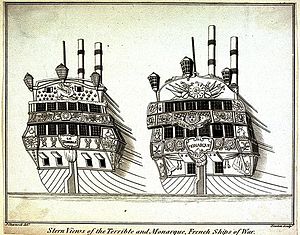 Drawings of the sterns of two French 74-gun warships captured at Cape Finisterre in October 1747. On the left is Terrible, and on the right, Monarque
| |
| History | |
|---|---|
| Name | Monarque |
| Builder | Brest |
| Laid down | January 1745 |
| Launched | March 1747 |
| Completed | July 1747 |
| Captured | By the Royal Navy on 14 October 1747 |
| Name | HMS Monarch |
| Builder | Brest Dockyard |
| Laid down | January 1745 |
| Launched | March 1747 |
| Completed | July 1747 |
| Acquired | 14 October 1747 (by Britain) |
| Fate | Sold for breaking up on 25 November 1760 |
| General characteristics | |
| Class and type | 74-gun third rate ship of the line |
| Tons burthen | 1,776 17/94 bm |
| Length |
|
| Beam | 47 ft 2.5 in (14.4 m) |
| Depth of hold | 20 ft 1.5 in (6.13 m) |
| Sail plan | Full-rigged ship |
| Complement | 650 |
| Armament |
|
HMS Monarch was originally the 74-gun ship of the line Monarque of the French Navy launched in March 1747. Captured on 14 October 1747, she was taken into Royal Navy service as the third rate HMS Monarch.
Monarque was built during the War of the Austrian Succession at Brest to a design by Blaise Ollivier, but lasted only a few months in French service. She was captured by the British just three months after being completed, one of several prizes taken by Sir Edward Hawke's fleet at the Battle of Cape Finisterre. Brought into the Royal Navy, she was used for the rest of the War of the Austrian Succession as a guardship and to carry troops. She saw service during the Seven Years' War, forming part of fleets sent to North America and the Mediterranean under Hawke, Boscawen and Osborn, and being commanded at one stage by future admiral George Rodney.
Monarch was the scene of the execution of Admiral Sir John Byng, who had been sentenced to death for failing to do his utmost during the Battle of Minorca (1756), and was shot on Monarch's quarterdeck on 14 March 1757. Monarch went out to the Mediterranean during the last years of the Seven Years' War, and played a role in the British victory at the Battle of Cartagena. She returned home and was reduced to harbour service, and was sold for breaking up in 1760.